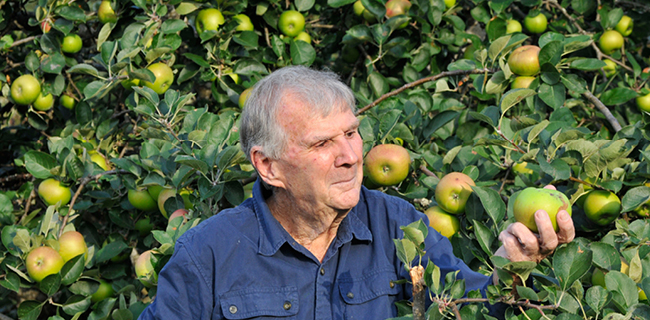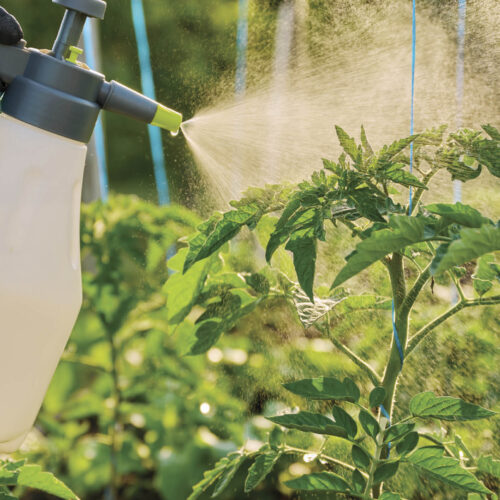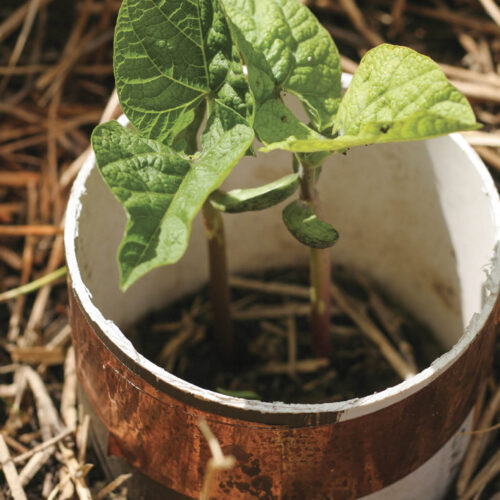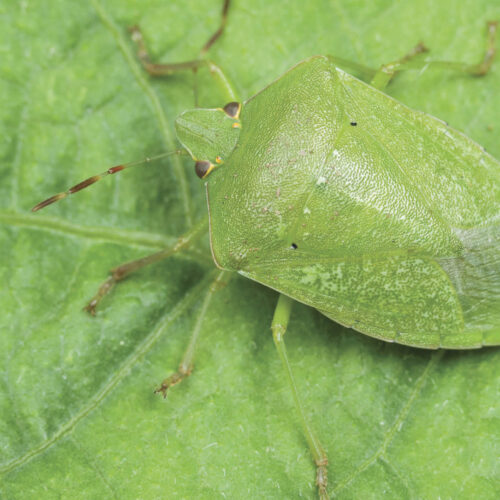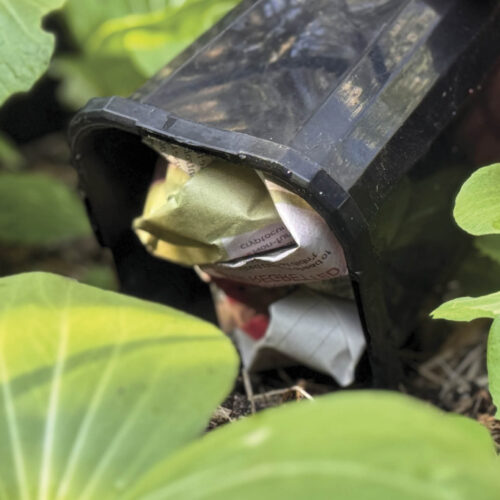On fruit patrol
2017-12-13T13:00:01+11:00
There can be some nasty pests and diseases in the summer orchard.Try Peter Cundall's trusted control methods.
When we started our Tasmanian garden about 35 years ago I took advantage of our relatively cool winters to plant a wide range of deciduous fruit trees. The aim was partly to provide all the apples, pears, peaches, nectarines, apricots, plums, quinces and berry fruit we needed to eat, store or give away.
But our trees were also experiments. I needed to learn more about pest and disease control and produce high-quality fruit without using poisonous sprays or life-disrupting chemical fertilisers.
Despite mistakes, the results have been remarkably successful. My biggest blunder initially was to ignore seemingly insignificant attacks from pests and diseases. Lessons learned – eternal vigilance is clearly the price you pay for healthy trees and fruit. Pests and diseases relentlessly multiply over the seasons, unless dealt with early. If not nipped in the bud, they easily overwinter to strike again the following spring.
Luckily, there are safe, efficient controls using organic techniques. Here are some of the important ones. You may have to adapt advice if you are in the tropics and sub-tropics but nurseries can be very helpful.
Powdery mildew
Apple trees and grape vines are susceptible to powdery mildew, a serious fungal disease that restricts growth and reduces yields. The apple variety ‘Jonathon’ is particularly vulnerable – growing branch tips look as though they’ve been dipped in grey ash. Prune and collect diseased shoots as fast as they appear and especially tip-prune during winter to remove shrivelled, disease-laden twiggy growth.
Apple scab
Another fungal disease, scab causes both apple and pears to be covered with black, sunken spots. They spread over skins causing serious distortion and if not controlled entire trees remain infected and crops wasted.
The fungal spores arise from diseased leaf and fruit debris lying on the ground during spring rains after overwintering beneath trees. In order to penetrate and infect tissue,
spores need leaf surfaces, which remain wet for several hours. As infected leaves shrivel and go black, new spores move on to developing apples.
To control the disease in the home garden, use a combination of strict hygiene, pruning and prevention of the spring spore-rise. That means removing all fallen fruit and other debris from beneath infected trees from late summer. I use a lawn mower – catcher attached – to scalp the surface while sucking up and collecting diseased material. Sprinkling high-nitrogen liquid fertiliser, such as diluted fish emulsion, to speed up decomposition of remaining debris, immediately follows this.
In early winter, quick-acting hydrated lime is spread to encourage a high population of earth-cleansing earthworms. Selective pruning at any time, not only removes overwintering scab organisms (seen as blistering on twiggy shoots and old fruit spurs), but opens up congested tree canopies for better air circulation and quicker leaf drying during spring’s crucial, scab-infection period.
My most successful method of suppressing apple scab spores from rising and infecting trees has been to sandwich thick, multi-page mulches of overlapping newsprint between a double layer of pelletised chook manure. This newsprint-based mulch extends from trunks to well beyond drip-lines and is best applied in late winter but helps control if applied at any time during the growing season. Water to make sure the soil is damp if there has been no recent rain. The paper is wetted, then weighed down with more manure to be finally covered with a heavy mulch of straw.
These tight, compact barriers are dense enough to keep scab spores harmlessly trapped at soil level during spring. Later the newspapers and straw rot to feed the soil after the scab danger has passed.
Newsprint mulches also control pear and cherry slug infestations.
Codling moth
Codling moth grubs are serious pests that affect apples, pomegranates, pears, quinces and stone fruit. In spring and summer, moths lay flattish, pinhead-sized eggs on or near immature fruit. As grubs hatch they immediately burrow to cores, feed off seeds, then eat their way out, emerging fully fed to hide in bark crevices.
Later they emerge as moths, with males flying away while females remain, fluttering each evening while producing a male-attracting pheromone scent.
At the end of summer as temperatures fall, the last of the grubs crawl into bark or nearby crevices to overwinter, emerging as moths in spring to start the breeding and attacking cycle again.
My organic grub control methods have proven very effective. I inspect all immature fruit – which usually need thinning – to remove and collect those that have been attacked; they’re easily identified by black frass emerging from small holes. These and all windfalls are placed in sealed plastic bags and left in the sun, which kills the grubs.
I also hang pheromone lures (sticky traps available at garden centres), which produce a female scent to distract and capture incoming male moths. Every winter I use a steel brush and a small screwdriver to remove flaky bark to expose and kill over-wintering grubs. A collar of corrugated cardboard, or hessian sacking, tied on the trunk, can be used to attract pupating caterpillars. Check, destroy and replace at Christmas and twice again through summer-autumn.
Woolly aphids
Woolly aphids look like clusters of cotton wool clinging to apple branches (sometimes pear and crabapple). These pests suck sap and cause ugly lumps as trees continually try to form healing calluses. Control is quick and easy by painting aphid colonies with methylated spirits for an immediate kill.
Pear and cherry slugs
Tiny, leaf-skeletonising grubs protected by sticky brown, slug-like goo, pear and cherry slugs infest the foliage of apple, pear, cherry, plum, quince, crabapple, hawthorn and related ornamental trees, first appearing in late spring
and rapidly increasing in numbers over summer. They cause massive leaf shrivelling and if not controlled growth becomes stunted and fruit yields reduced.
The grubs are larvae of a small, shiny sawfly, which inserts its eggs into leaf tissue. Hatching several days later, the tiny grubs feed by grazing on leaf surfaces. When fully fed,
the grubs fall to the ground in late December, burrow into the earth and emerge as sawflies over the following weeks, this time in far greater numbers to almost defoliate most trees. From mid-autumn, most mature grubs overwinter in the soil, emerging as sawflies in late spring to resume the destructive breeding-feeding cycle.
I’ve obtained complete control of pear and cherry slugs by standing up-wind to scatter hydrated (builders’) lime over the foliage. This stuff sticks to the pests so they shrivel and die overnight. Even though leaves remain white with lime – despite rain showers – growth continues unchecked. Fine dry sand can also be used, especially for acid-loving quince trees; another alternative is wood ash.
I’ve also discovered that newsprint-based mulches, identical to those used to control apple scab, also prevent sawflies from emerging from the ground. While the ideal time to apply suppressing mulches is early spring, they can be almost as effective when used to stop the second and subsequent generations in early summer.
Black peach aphids
Black peach aphids clustering thickly on young stone-fruit growth multiply so rapidly they appear almost invincible.
Yet a single squirt of organically certified pyrethrum, applied in the evening after bees have returned to hives, kills the lot in seconds. The only time to avoid spraying is when aphid- eating ladybirds are also present. They can do the job far more efficiently without disrupting the balance of life.
Brown rot
The most frustrating problem with all stonefruit is brown rot, a fungal disease that causes plums, peaches, apricots and other stonefruit to rot as they begin to ripen. The disease really strikes in late winter, first causing blossoms to wither, turn almost black and remain clinging. The disease organisms remain dormant until the fruit begins to mature in summer. Small blobs of toffee-like gum oozing from twiggy growth indicate sources of infection. Spores emerge to infect fruit as ripening approaches, first seen as brown dots that rapidly expand, turning entire fruit clusters rotten.
Brown rot overwinters in dry, shrunken, clinging mummified fruit, gum-oozing branches and diseased fruit lying beneath trees. Control is by hygiene, which means constantly collecting all fallen fruit, cutting out mummies, plus the growth to which they are attached. Pruning out all infected material at any time of the year and carefully raking up and removing all pruning debris is also necessary.
For more organic growing ideas and practical solutions subscribe to the magazine here.

